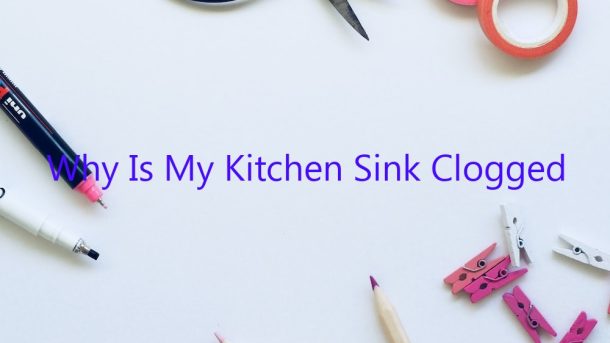A clogged kitchen sink can be a real annoyance. Not only does it make it difficult to do dishes, but it can also be a breeding ground for bacteria. If you’re dealing with a clogged kitchen sink, there are a few things you can do to try to fix it.
The most common cause of a clogged kitchen sink is a build-up of food particles and grease. This can be caused by improper dishwashing habits, such as not cleaning dishes before putting them in the sink, or by improper plumbing. In some cases, the clog may be caused by a foreign object that has been accidentally dropped down the sink drain.
If your kitchen sink is clogged, the first thing you should do is try to clear the clog with a plunger. If the clog is caused by food particles, the plunger should be able to dislodge them. If the clog is caused by a foreign object, the plunger may not be able to dislodge it, but it may help to push the object further down the drain.
If the plunger doesn’t work, the next step is to try to clear the clog with a snake. If you’re comfortable using a snake, it may be able to dislodge the clog. However, if the clog is caused by a foreign object, the snake may not be able to reach it.
If the snake doesn’t work, the next step is to try to clear the clog with a chemical drain cleaner. Be sure to read the instructions on the chemical drain cleaner carefully, and always use caution when using these products.
If the chemical drain cleaner doesn’t work, the next step is to call a plumber. A plumber may be able to clear the clog using a snake or a hydrojet.
If you’re having trouble with a clogged kitchen sink, the best thing to do is to try to clear the clog with a plunger. If that doesn’t work, try a snake. If that doesn’t work, try a chemical drain cleaner. If none of those methods work, call a plumber.
Contents
How do you unclog a kitchen sink with standing water?
When your kitchen sink becomes clogged with standing water, it can be a frustrating experience. Fortunately, there are a few things you can do to try to unclog it. One option is to use a plunger. Put the plunger over the drain and plunge up and down a few times. You may also want to try pouring a pot of boiling water down the drain. If this doesn’t work, you may need to call a plumber.
How do you unclog a sink that won’t drain?
There are a few different ways to unclog a sink that won’t drain. The most common way is to use a plunger. You can also use a wire hanger or a snake.
To use a plunger, you need to fill the sink with water. Then, put the plunger over the drain and push and pull the plunger up and down. You should also try to create a seal around the plunger.
If the plunger doesn’t work, you can try using a wire hanger. Bend the hanger so that it forms a hook. Then, put the hook into the drain and try to pull the clog out.
If the wire hanger doesn’t work, you can try using a snake. You can buy a snake at most hardware stores. Put the snake into the drain and try to pull the clog out.
Why is my kitchen sink backing up?
If your kitchen sink is backing up, it’s likely that something is blocking the drain. This can be caused by a build-up of food or grease, or by something that has been accidentally dropped down the drain.
To clear the blockage, you can try using a plunger. If that doesn’t work, you may need to use a cable auger to clear the drain.
If the blockage is caused by a build-up of food or grease, you can try to clear it by using a vinegar and baking soda solution. boiling water, or a commercial drain cleaner.
However, you should always take care when using drain cleaners, as they can be dangerous if used incorrectly.
If the blockage is caused by something that has been dropped down the drain, you may be able to clear it by using a metal hanger.
What are the most common causes of sink blockage?
Most people take the convenience of their sink for granted until it becomes clogged and they are unable to use it. Sink blockages can be caused by a variety of things, some of which are easy to fix, while others may require the services of a professional plumber. In this article, we will take a look at the most common causes of sink blockages.
One of the most common causes of sink blockages is a build-up of grease and food particles. This can be easily fixed by clearing the drain with a plunger or by using a chemical drain cleaner.
Another common cause of sink blockages is hair. This can be fixed by using a drain trap or a hair catcher.
A third common cause of sink blockages is objects such as toys or pens which have been accidentally dropped down the drain. This can be fixed by using a drain snake to remove the object from the drain.
If the sink blockage is not caused by any of the above-mentioned things, it may be caused by a problem with the plumbing. In this case, it is best to call a professional plumber to fix the problem.
How do you unclog a severely clogged kitchen sink?
A clogged kitchen sink can be a real hassle. If it’s severely clogged, it may be difficult or impossible to clear with simple methods. In these cases, it’s necessary to use a plunger or a snake.
If the sink is clogged with food, the simplest way to clear it is to pour a pot of boiling water down the drain. This will soften the food and make it easier to clear. If the clog is caused by grease or hair, a plunger may be more effective.
To use a plunger, insert it into the drain and push and pull it up and down. This will create a suction that will clear the clog. If the clog is very severe, a snake may be necessary.
A snake is a long, thin tool that can be inserted into the drain to clear the clog. It can be purchased at most hardware stores. Be sure to read the instructions carefully before using a snake, as it can be dangerous if used incorrectly.
If none of these methods work, it may be necessary to call a plumber.
Can plunging make a clog worse?
Can plunging make a clog worse?
Plunging is a common method for removing a clog from a drain. However, there is a chance that plunging can make the clog worse. When plunging, it is important to use the right technique and to have a good seal around the drain. If either of these things is not done correctly, the plunger can push the clog further down the drain.
If the clog is close to the surface, plunging may be able to remove it. However, if the clog is deeper down in the drain, plunging may not be able to reach it. In this case, the clog will just be pushed further down the drain.
If you are having difficulty removing a clog with plunging, it may be necessary to try a different method. A plumbing snake may be able to reach the clog and remove it. If the clog is caused by a build-up of grease or hair, a chemical drain cleaner may be able to break it up.
Why is my sink water not going down?
If your sink’s water flow suddenly decreases and the water doesn’t seem to be going down the drain, it’s likely that you have a clog. This can be caused by a variety of things, from food particles to hair, so it’s important to troubleshoot the issue as soon as possible.
One of the easiest ways to check for a clog is to pour a pot of boiling water down the drain. If the water quickly flows down the drain, then the clog is likely near the top of the pipe. If the water doesn’t move, however, then the clog is likely further down the pipe. In this case, you’ll need to use a plunger to try to dislodge the clog.
If pouring boiling water doesn’t work, you can also try using a chemical drain cleaner. Be sure to read the instructions carefully, and always use caution when working with these products.
If the clog is still not cleared, you may need to call a plumber to inspect the pipes. Clogs can often be difficult to clear on your own, and left untreated, they can lead to further damage to the pipes.




